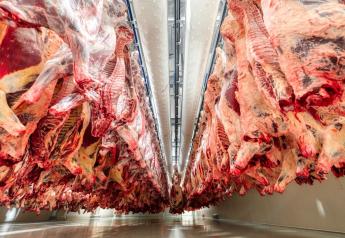Clearing the air on livestock GHGs
A cloud of misinformation continues to fog public perceptions of the role of livestock in greenhouse gas (GHG) emissions, but University of California, Davis, professor and air-quality specialist Frank Mitloehner, Ph.D., is working to clarify the issue.
Mitloehner recently published a white paper titled "Livestock's Contributions to Climate Change: Facts and Fiction," that shows food animals are minor contributors to U.S. and global GHG emissions.
Unfortunately, fiction regarding this issue continues to influence the public, and public policy around the world.
Just this week, news out of Denmark indicated the government there is considering levying a tax on red meat to change eating habits and help reduce GHG emissions. In proposing the tax, the Danish Council of Ethics said cattle accounted for around 10% of the CO2 released into the atmosphere, while food production makes up around another 20%. Here in the United States, special interest groups repeatedly claim that livestock account for up to 51% of all GHG emissions - as much as or more than the transportation and energy sectors.
In the white paper, Mitloehner notes that the U.S. Environmental Protection Agency and leading scientists have quantified livestock as the source of just 4.2% of all U.S. GHG emissions.
The transportation and energy sectors, meanwhile, contribute 27% and 31% of U.S. GHG emissions respectively and 58% combined. According to EPA data, beef cattle contribute 2.2%, dairy cattle 1.37%, swine 0.47%, poultry 0.08% and sheep, goats and other livestock contribute 0.08% of GHG emissions.
Livestock GHG emissions have declined over time in the United States, largely because of amazing improvements in production efficiency. In 1950, according to the Mitloehner paper, the United States had 22 million dairy cows and produced 117 million tons of milk annually. In 2015, U.S. dairies housed just 9 million cows but produced 209 million tons of milk - a 59% reduction in cow numbers and a 79% increase in milk production, resulting in dairy GHG emissions of just one-third those in 1950.
The beef industry has generated similar improvements. Beef cattle numbers declined from 140 million head in 1950 to 90 million head in 2015, a 36% reduction, while beef production remained stable at 24 million tons.
Activists are happy to tell you that eating a hamburger is equivalent to driving a Hummer, and that observing "Meatless Mondays" can save the world. Mitloehner's figures show that if all Americans adopted Meatless Mondays, the reduction in U.S. GHG emissions would total 0.6%.
In contrast, if Americans replaced incandescent lightbulbs with "Energy Star" rated bulbs, the reduction in GHG emissions would be 1.2%, twice that from abstaining from meat.
"One certainly cannot neglect emissions from the livestock sector," Mitloehner says, "but to compare them to the main emission sources would put us on a wrong path to solutions, namely to significantly reduce our anthropogenic carbon footprint to reduce climate change."
Read the full white paper from Dr. Mitloehner at the University of California, Davis.







